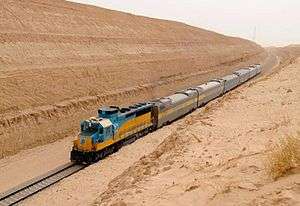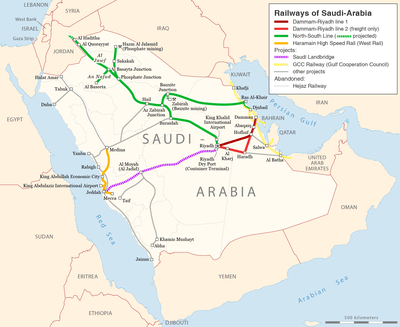Dammam–Riyadh line
The Dammam–Riyadh line is a passenger railway line in Saudi Arabia, linking the Eastern Province's capital city of Dammam with the Saudi capital Riyadh. The 449 km line has four stations. It is operated by the Saudi Railways Organization (SRO).
| Dammam–Riyadh line | |||
|---|---|---|---|
 A train on the Dammam–Riyadh Line. | |||
| Overview | |||
| Type | Inter-city rail | ||
| Locale | Eastern Province and Riyadh Region, Saudi Arabia | ||
| Termini | Dammam Riyadh | ||
| Stations | 4 | ||
| Website | saudirailways.org | ||
| Operation | |||
| Opened | 1981 | ||
| Owner | Saudi Railways Organization (SRO) | ||
| Character | At-grade | ||
| Rolling stock | CAF push-pull train | ||
| Technical | |||
| Line length | 449 km (279 mi) | ||
| Number of tracks | 2 | ||
| Track gauge | 1,600 mm (5 ft 3 in) | ||
| Electrification | None | ||
| Operating speed | 180 km/h (110 mph) | ||
| |||
History
The Dammam–Riyadh line was opened in 1981.
Upgrade
There is an upgrade ongoing to replace level crossings with grade separations,[1] and to bypass of the centre city of Hofuf.[2] This shall allow 200 km/h speed.
In 2014, the SRO awarded a contract worth US $1.6 million to a consortium led by Spanish firm Consultrans to study alignments for a high-speed line linking Riyadh and Dammam.[3]
In December 2015, the SRO President stated that the speed of trains on the line would be raised from 140 km/h to 160 km/h before the end of the year, and would further be increased to 180 km/h in 2016.[4] On 7 December 2015, SRO began operating passenger services on the line using new CAF push-pull trainsets which operate at 180 km/h. The trains entered service just as the SRO had completed double-tracking of the entire 449 km line.[5]
On 17 February 2017 at about 1:00 am, a train on the line derailed near Dammam, injuring 18 people, after flooding from torrential rains caused the rail line to erode. The train was carrying 193 passengers and six crew members. SRO stated that all injuries were minor. All passengers were transferred to another train and transported to Dammam station.[6] The line was closed for repair following the accident, and SRO suspended all rail services to Dammam. Services were only operated between Riyadh and Hofuf.[7] Full services were resume by 23 February 2017.
Stations
The stations at Dammam, Hufuf and Riyadh were designed by Lucio Barbera and designed and built between 1978 and 1980. They were opened for public service in 1981. The terminus stations in Dammam and Riyadh are extremely similar and consist of a rectangular hall of three naves separated by two lines of pillars along the ends of the tracks and two wings at the ends of the main hall along the outer tracks. The design is based on the layout of some mosques along the Mediterranean Sea, where the prayer hall is located at one side of a court with lesser wings along the sides of the court.[8] The style and decoration of the buildings uses elements such as triangular openings to construct windows and arcades and parapets with rectangular steps,[9] elements bearing a resemblance to Nejd architecture but also common in other Arab architecture. The station building in Hufuf lies to the east of the through line along one side. The decoration is very similar to the stations in Dammam and Riyadh.
There are four stations on the Dammam–Riyadh line:
| # | Station name | Distance from origin | |
|---|---|---|---|
| English | Arabic | ||
| 1 | Dammam | الدمام | 0 km |
| 2 | Abqaiq | بقيق | 74 km |
| 3 | Hofuf | الهفوف | 139.26 km |
| 4 | Riyadh | الرياض | 449 km |
Infrastructure
Rolling stock
The SRO's fleet consists of 102 diesel locomotives and 75 passenger cars. These are classified into 12 cars of Al-Rehab class with a capacity of 540 seats, 9 cars of Al-Taleaa class with a capacity of 652 seats, 25 cars of Al-Qafila class with a capacity of 2,012 seats along with 2 special-class cars, 8 diner cars, 12 luggage and power generation cars and 1 car that has been specially fitted as an ambulance car to enhance safety.[10]
Spanish manufacturer CAF has in delivered 2012 delivered eight fast diesel locomotives, with one driving van trailer passenger car and four other passenger cars, with a leading power car unit; plus two spare power cars. They are used on the Dammam–Riyadh Line. During 2013 the travel time is 4:15 but there is a target of 3:00 for the future.
| Class | Image | Top speed | Number | Remarks | Built | |
|---|---|---|---|---|---|---|
| mph | km/h | |||||
| EMD SW1200 | 5 | Diesel-electric locomotives. Series 1022-1026[11] | 1950-60 | |||
| Class 2400 |  |
50 | 80 | 7 | Secondhand Diesel-electric locomotives taken over from NS by Volker Stevin in 1976 for construction works for a seaport in Jubail. Former 2427, 2445, 2485, 2497, 2499, 2519, 2523. Renumbered into 101-107. Sold to Archirodon for rail reconstruction between Damman and Riyadh and renumbered to 276-04 - 276-09. Some scrapped in 1983. Others active until 1994 and stored in Hofuf afterwards.[12] | 1954-56 |
| EMD GP18 | Diesel-electric locomotives. 1200[11] | |||||
| EMD FP7A | 2 | Diesel-electric locomotives taken over from Arabian American Oil Company (there 1006-1007).[13] | ||||
| EMD SD38-2 | 6 | Series 2004-2009. Order 778050. Diesel-electric locomotives[14] | 1978 | |||
| EMD SD50 | Diesel-electric locomotives[15] | |||||
| EMD SD70ACS | 25 | Diesel-electric locomotives for a mineral railway[16] | 2010 | |||
| CAF | 112 | 180 | 8 Passenger Units & 10 Power Cars (5001-5010) | Passenger Trainsets with dedicated Power Cars. | 2011 | |
| Class 319.2 | 75 | 120 | >4 | (Series 319.)Diesel-electric locomotives bought second hand.[17] | ||
Tracks
The rails on the line are of the type C.W.R UIC 60.[18]
Signaling system
In 2007, the SRO contracted a consortium made up of Siemens Transportation Systems and the Saudi Arabian Nour Communications Company to modernize both the Dammam–Riyadh line and the cargo line of SRO rail network. The line will be equipped with signalling technology including an electronic interlocking as core of the installation and Trainguard 100 for ETCS Level 1. GSM-Railway (GSM-R) mobile radio technology will be used for communications on the entire rail network.[19]
Operations
The total journey time is about 4.5 hours.[20] From 1 June 2016, SRO began operating an express train that covered the distance between Riyadh and Dammam in 3 hours 40 minutes. The train departs from Dammam at 9:30AM and from Riyadh at 1:10 PM daily.[20]
References
- 30-year railway master plan
- Hofuf bypass contract
- http://infrastructureme.com/2015/09/revisiting-rail/
- "Riyadh-Dammam high-speed train planned". Arab News. 15 December 2015. Retrieved 10 February 2017.
- UK, DVV Media. "SRO launches push-pull trains at 180 km/h". Railway Gazette. Retrieved 12 February 2017.
- "Floods cause train to derail near Saudi's Dammam, injuring 18 - Gulf Business". Gulf Business. 19 February 2017. Retrieved 24 February 2017.
- "Saudi rail operations expected to resume on Friday after flooding - Gulf Business". Gulf Business. 20 February 2017. Retrieved 24 February 2017.
- A short description Archived 2012-05-09 at the Wayback Machine of the Dammam station at ArchNet.org with a comparison of the station plan to the layout of the Al-Ashar mosque in Cairo and other pictures.
- On this page Archived 2005-01-13 at the Wayback Machine at the website of Lucio Barbera, click on the year 82 of the "Integrated Projects" time line to see a plan some drawings and pictures.
- https://www.saudirailways.org/sites/sro/Pages/en-us/AboutUs/Statistics/OurFleet.aspx
- ttnut.om
- Dierdorp, Sicco & Davy Beumer (2011), D.E.-Locomotieven serie 2200/2300 en 2400/2500. Alkmaar: De Alk
- rrpicturesarchives.net
- Trainweb.org
- Railpictures.net
- HaRakevet: Rothschild PhD, Rabbi Walter (2010), New mineral railway Issue 90
- "World rolling stock market May 2014", www.railwaygazette.com, 11 May 2014
- Saudi Railways Organization. "Technical Information". Archived from the original on 2008-04-11. Retrieved 2008-07-09.
- Siemens AG. "Dammam - Riad, Saudi Arabia". Retrieved 2008-07-09.
- "Dammam-Riyadh train trip in just 3 hours, 40 minutes". Arab News. 20 May 2016. Retrieved 10 February 2017.
